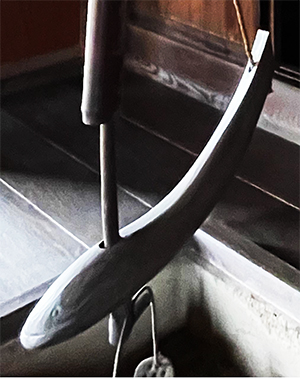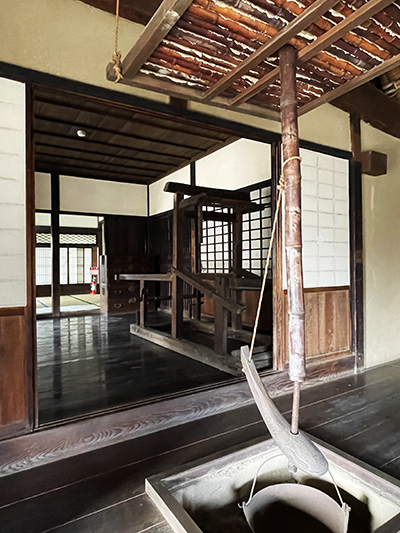


現代生活で失われた日本人のライフデザイン要素として囲炉裏がある。囲炉裏は日常食の食卓であり、家族の中での自然な「座り位置」関係の表現まで含めて日本人の意識を潜在的に規定してきた。
最上位の位置は、土間方向に向かっていちばん座敷側になる位置。左右に家族が座って、もっとも上座の場所に家族でのいちばんの権威者が座っていた。通常は戸主がその座を占めていた。わが家の古い記憶では家長としての祖父がその場に常にいたように記憶している。しかし、そうであっても家族団欒の象徴的な場所であることは間違いがなく、筋を通しながら、家族のいのちと共感を繋ぐ空間だった。
そういう囲炉裏に掛ける鍋類を「腕木」で火力を調整した。煮立てるまでは火に近づけて、煮たってしまったら、今度は温度維持に変化させたのだ。言ってみれば火力の段階調整具。
この装置のデザインでは圧倒的に「お魚」さんが主流を形成した。
日本人のタンパク源取得が圧倒的に魚類だったことが関係しているのか、あるいは鍋料理としては基調的な味覚はさかなが支配的だったことに起因しているのか。いずれにせよ、そのデザインは魚が主流。どうして魚なのだろうか?また外国ではそもそも囲炉裏や自在鉤ってあるのだろうか、どうなのか?
「魚は水に通じるということで火事を避けるお守りの意味があり、また魚には瞼がないことから眠らないー居眠りして火を絶やさないとか、目を離して火事を起こさないという意味がある」という説。これが主流の解釈のようです。しかし鍋料理の主役が魚であることの方がしっくりと馴染む気がする。
またこのテーマでWEB検索してみても、中国雲南省の民家で囲炉裏が見られる程度で、欧米の場合はやはり「暖炉」であって囲炉裏という暖房兼用の調理文化は見られないようだ。
そのように考えてくると、囲炉裏という文化自体が日本人の精神性形成に非常に大きな影響をもたらした生活文化であることが見通せてくる。欧米人と比較して「家」意識が濃厚なのが日本人だと思うけれど、個人主義とは相当に乖離のあるこうした倫理意識が、日本人の本質なのかも知れない。武士たちは、家の存続のために自分のいのちを賭けて戦っていた。自分が死んでも家が存続していくために命をなげうったのには、囲炉裏を囲んで常に家意識を高め続けた生活文化が大きいのかも知れない。
そういう囲炉裏火力で、ユーモラスなお魚さんがキーデザインになっていることも面白い。縄文以来、海の幸、川の幸の主役として日本人の心の底に魚の残像が刻印され続けてきたようですね。
English version⬇
Fish Designs for Irori Fireplace Heat Adjustment: Hikawa Shrine’s Yuhisha and Anrakuji Temple’s Kori-4
Fish is the mainstay of the pot dish that hangs over the hearth as a folk tradition. This unconscious area continued to be imprinted at the base of the Japanese sense of home. The…
One element of Japanese life design that has been lost in modern life is the hearth. The hearth is the dining table for daily meals and has subconsciously defined the Japanese consciousness, including the expression of the natural “sitting position” relationship within the family.
The highest position is the one that is farthest toward the earthen floor on the tatami room side. The family members sat on either side, and the person with the most authority in the family sat in the most senior position. Usually, the head of the household occupied this position. In my family’s old memories, my grandfather as the patriarch of the family was always present. Even so, there is no doubt that it was a symbolic place for family reunion, a space that connected the family’s life and sympathy while making sense of it.
The pots and pans that hung over such a hearth were adjusted in terms of fire power with an “arm tree. The pots and pans were placed close to the fire until they were simmering, and once they were simmering, the temperature was maintained at a constant level. In other words, it is a device that adjusts the heat power in stages.
Fish” formed the overwhelming mainstream in the design of this device.
Perhaps this is due to the fact that fish was the predominant source of protein for the Japanese, or perhaps it is due to the fact that fish was the dominant taste in nabe dishes. Either way, its design is dominated by fish. Why fish? And in foreign countries, do they have hearths and free-standing hooks, or not?
The theory is that “fish is connected to water, which means it is a talisman to avoid fire, and since fish have no eyelids, it means that they do not sleep – they do not doze off and keep the fire going, or that they do not take their eyes off the fire and cause it to burn. This seems to be the mainstream interpretation. However, I think it is more fitting that fish is the main ingredient in nabe dishes.
In addition, a web search on this theme shows that hearths can only be found in private homes in China’s Yunnan Province, and it seems that in the West, the hearth is still a “fireplace” and not a hearth, a cooking culture that doubles as a heating system.
In this way, we can see that the hearth culture itself is a lifestyle culture that has had a very significant impact on the formation of the Japanese mentality. The Japanese have a strong sense of “home” compared to Westerners, but this sense of ethics, which is quite different from individualism, may be the essence of the Japanese people. Samurai warriors fought for the survival of their families, risking their own lives. Perhaps the reason why they sacrificed their lives to ensure the continuation of the family even after their own deaths was due in large part to their culture of living around the hearth, which constantly heightened their sense of family.
It is interesting to note that humorous fish are a key design element of such hearth fire power. It seems that since the Jomon period, the afterimage of fish has continued to be imprinted deep in the hearts of Japanese people as the mainstay of seafood and river food.
Posted on 7月 30th, 2023 by 三木 奎吾
Filed under: 住宅性能・設備, 日本社会・文化研究







コメントを投稿
「※誹謗中傷や、悪意のある書き込み、営利目的などのコメントを防ぐために、投稿された全てのコメントは一時的に保留されますのでご了承ください。」
You must be logged in to post a comment.